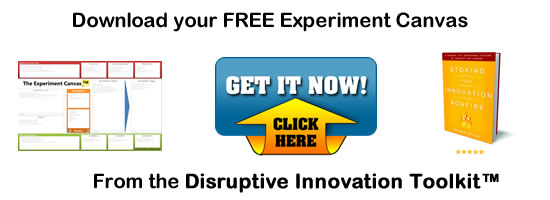You Cannot Craft A New Strategy Until…
 …you’ve defined the problem with the old one, reframed it as a choice between at least two mutually exclusive options, and generated some initial possibilities through focused, facilitated brainstorming.
…you’ve defined the problem with the old one, reframed it as a choice between at least two mutually exclusive options, and generated some initial possibilities through focused, facilitated brainstorming.
(Side rant to all the creativity “experts” out there poo-pooing brainstorming: Go pound sand. Brainstorming works very well with proper focus and facilitation. Creativity thrives under intelligent constraints.)
Let’s assume you’ve got clarity and consensus on your current strategy (If you’re not, check this post for a list of questions to help you achieve clarity), using Roger Martin’s Playing To Win framework. That is, you’re clear on:
- Your current winning aspiration,
- The spaces in which you’re currently competing,
- The basis of your advantage in those spaces,
- What specific activities and capabilities produce that advantage, and
- The systems which support and sustain those capabilities.
Here are the three things you need to do before you dive into drafting a new 5-point strategic cascade.
1. STATE YOUR PROBLEM
The first thing you need to do is to agree on the most pressing and troublesome strategic problem you’re facing. Has your leadership position slipped? Is market share shrinking? Have competitors surpassed you with better products or services? Is growth not happening as fast as you’d like? Are your capabilities becoming irrelevant with end users?
As with any problem solving, you’ve got to grasp the current situation and identify the strategic issues that have you thinking you need a new strategy in the first place.
If you’re not sure where to start, walk through the areas that you’ll eventually reverse engineer with “strategy’s magic question” (i.e. what must be true?). Basically, you want to discuss current challenges in your chosen segments, your channel customers, your end users or consumers, and your capabilities and costs in comparison to your competitors.
If you’re like most of us, our current strategy is rather target-rich…meaning you have more than one pressing issue. Pick the one that’s keeping most everyone up at night. That’s your bogey.
2. REFRAME YOUR PROBLEM
Here’s where strategy differs from problem solving. You’ll be tempted to begin analyzing the problem. Don’t. Instead, reframe the problem as at least two mutually exclusive high-altitude approaches to the problem. For example, if your problem is inferior capabilities versus your competitors, the choices could be between building new capability and outsourcing. (At the most generic level, the choice is always going to be between more of something and less of something. The language may change, but the basic choice remains the same. e.g. “broaden vs. narrow,” “up market vs. down market,” “generalization vs. specialization,” etc.)
One of the key ideas in the Martin framework is that successful strategy combines logic and creativity. In other words, there’s an art to strategy, and as that clever guru of strategy Frank Zappa once said, “The most important thing in art is the frame. For paint, literally. For other arts, figuratively — because without this humble appliance, you can’t know where the art stops and the real world begins.”
3. BRAINSTORM POSSIBILITIES, CLUSTER & CULL
You’re still not ready to dive into the new strategy work just yet, basically because you have nothing to dive in to. What you want to dive into is possible where to play/how to win combinations that you riff off of each of the two choices that reframe your problem. In other words, you’re looking for a good double fistful of “how-to’s” for the two choices…possible ways to
This is where a solid 30 minutes or so of brainstorming will work wonders. When I work with groups, I like to split that 30 into 15 minutes of individual brainstorming and 15 minutes of group brainstorming. The first 15 makes the second 15 very productive.
Roger Martin likes to approach brainstorming possibilities as “a happy story about a potential future that lays out where your company plays and how it will win there.” Start by thinking up different ways to either broaden or narrow where you play. Think through the various spaces in the categories of customer segments, channels, product/service offerings, geography, stage of production, etc.
Then you can think about various ways of winning. One creative device might be to play the “what would X do?” with respect to what Michael Porter in his seminal Competitive Strategy identified as the only two broad categories of competitive advantage: low cost or differentiation. So, “what would Amazon do?” (low cost) or “What would Apple do?” (differentiation) in these spaces.
Note: you’re still not into drafting a strategic cascade yet! You’re just brainstorming. And as with any brainstorm, you’ve got to synthesize your ideas into something both meaningful and relevant to the problem. The best way to do that is to simply cluster the where to play/how to win possibilities by general theme. You might have three basic themes: broaden, maintain, narrow. (Remember, you haven’t scrapped your current strategy, and it remains a viable strategy at the moment.)
The last thing you want to do is to cull those thematic possibilities into the few that you will then draft a full strategic cascade for. Roger Martin recommends three to five possibilities, plus the current strategy.
HYPOTHETICAL EXAMPLE: STAR FITNESS TRAINING
Joe and Mary Buff, former Crossfit winners, offer in-home personal training services to an upscale clientele in the Hollywood area. Their clientele, which includes some celebrities, pay a premium over even the highest-priced health clubs for their personal attention. They are very successful with this strategy, but have reached the limits of scale in their business and cannot take on new clients. They view it as a good problem to have, but a problem nonetheless.
They define the problem in three words: “ceiling on growth.” They reframe their problem as two choices: 1. expand into new client segments, and 2. offer new products to existing clientele. These are two completely different choices, and each has a number of possibilities:
- expand to cover all of Southern California by franchising Star Fitness Training
- extend into high-end health clubs
- expand through boutique storefront studios
- expand to downscale clientele with trainer certification model
- offer exercise DVD products
- offer nutritional products
- offer exercise equipment
Clustering these possibilities might look something like: A/grow geo area, B/diversify clientele, and C/fitness products:
A. Grow geo area:
- expand to cover all of Southern California by franchising Star Fitness Training
- extend into high-end health clubs
- expand through boutique storefront studios
B. Diversify clientele:
- expand to downscale clientele with trainer certification model
C. Fitness products:
- offer exercise DVD products
- offer nutritional products
- offer exercise equipment
From these seven, they select three possibilities they believe are worth exploring, and scrap the rest: 1/expand to all of Southern California through franchising, 2/expand into less affluent client segment by hiring, training, and certifying new training associates, and 3/offering exercise DVD products.
Next up: a tool to explore strategic possibilities.
Wait! Before you go…
Choose how you want the latest innovation content delivered to you:
- Daily — RSS Feed — Email — Twitter — Facebook — Linkedin Today
- Weekly — Email Newsletter — Free Magazine — Linkedin Group
 Matthew E. May is the author, most recently, of Winning the Brain Game: Fixing the 7 Fatal Flaws of Thinking.
Matthew E. May is the author, most recently, of Winning the Brain Game: Fixing the 7 Fatal Flaws of Thinking.
NEVER MISS ANOTHER NEWSLETTER!
LATEST BLOGS
Credit Card Shenanigans
It must be great to be in the credit card business in the United States. Demand is relatively inelastic and regulation is lax, so you can charge whatever you want for an interest rate, increase your fees once or twice a year, and make additional money off cash withdrawals and foreign exchange transactions.
Read MoreBuilding an Experience
As people become ever more immune to traditional advertising and marketing, branding will become more important. Branding is all about building an emotional connection with customers. Making the decision to follow a strategy focused on building a brand is not without peril, however, as it means that you will have to choose to not do certain things, like pursue a low price strategy.
Read More- « Previous
- 1
- …
- 4,132
- 4,133
- 4,134




